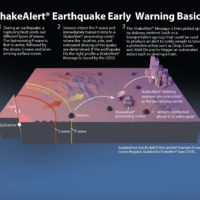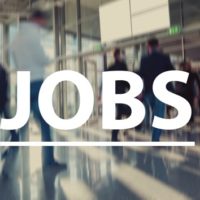
New technology is in place that alerts the public of a potential earthquake. ShakeAlert, an earthquake early warning system powered by the U.S. Geological Survey, uses science and technology to detect significant earthquakes quickly so alerts can reach people before shaking arrives.
“These seconds of advance warning allow people and systems to take actions to protect life and property from destructive shaking,” according to a Oregon Office of Emergency Management news release. “It is already in place along most of the West Coast and operational for key infrastructure systems such as automatic water valve shutoffs and starting back-up generators.”
In Oregon, ShakeAlert-powered alert delivery to wireless devices such as cell phones via the Wireless Emergency Alert (WEA) System, mobile apps and other technologies will begin as of 10 a.m. on March 11. No specific action is needed for WEA alerts and for cell phones using the Android operating system. One mobile app, QuakeAlertUSA, is currently available in Oregon.
March 11 coincides with the 10th anniversary of the M 9.1 Great Tohoku, Japan earthquake, which killed thousands and leveled cities. The Tohoku tsunami inundated coastal communities in Oregon, causing millions of dollars in damages. Like Japan, a subduction zone lies off the coast of Oregon, capable of generating M 9.0 earthquakes.
“This amazing technology could provide valuable seconds or tens of seconds on the front of an earthquake, not only mitigating lives lost by giving people a chance to seek shelter but also helping to drive a more efficient response,” said Andrew Phelps, director of the Oregon Office of Emergency Management. “The ability for first responders to take protective actions for themselves and their equipment means more resources to help Oregonians once the shaking stops.”
How it works
According to Robert de Groot, USGS ShakeAlert coordinator for Communication, Education, Outreach and Technical Engagement, ShakeAlert is an infrastructure of seismic sensors within a regional network that is part of the Advanced National Seismic System (ANSS), the Pacific Northwest Seismic Network (PNSN) and the California Integrated Seismic Network (CISN). A network of seismic sensors across California, Oregon and Washington are constantly measuring ground motion. They send this ground motion data to a USGS managed ShakeAlert processing center in Seattle, WA; Pasadena, CA; or Menlo Park, CA.
“When a sensor detects shaking, fast working algorithms and a state-of-the-art network may potentially give you seconds of warning before that seismic wave arrives to your location,” said Robert.
Algorithms take just a few seconds to do calculations and issue a ShakeAlert Message containing information about the estimated magnitude and area of shaking of the earthquake. The message is made available to ShakeAlert distribution partners such as utilities, hospitals, transportation systems, schools, emergency management agencies, etc., producing and delivering alerts, thus enabling people to take protective actions, such as drop/cover/hold on. In addition, ShakeAlert protects people and vital infrastructure by triggering automated actions such as closing water valves, starting back-up generators and issuing public announcements. For a ShakeAlert Message to be issued by the USGS, at least four seismic sensors need to detect the same ground motion.
What to do
When an alert is received, over a mobile device or from another communications channel, drop, cover and hold on.
-
- DROP where you are, onto your hands and knees – this position protects you from being knocked down and allows you to stay low and crawl to shelter if nearby. If no shelter nearby, crawl next to an interior wall (away from windows.
- COVER your head and neck with one arm and hand; if a sturdy table or desk is nearby, crawl under it and hold on with one hand. If there is no table or desk near you, maintain a crawling positon to protect your vital organs and be ready to move if necessary.
- HOLD ON until shaking stops.
Why ShakeAlert?
Oregon is one of the most earthquake-prone areas in the continental United States. Over the years, Oregon has had a series of earthquakes, large and small. Small earthquakes (
The Cascadia Subduction Zone is a 600-mile long fault that runs from northern California up to British Columbia and is about 70-100 miles off the Pacific coast shoreline. Oregon has the potential for an M 9.0+ earthquake caused by the Cascadia Subduction Zone and a resulting tsunami of up to 100 feet in height that will impact the coastal area. There have been 41 earthquakes in the last 10,000 years along this fault, occurring as few as 190 years or as much as 1200 years apart. The last M 9.0 (estimated) earthquake that occurred in this fault was on January 26, 1700.
Earthquakes strike suddenly, without warning and at any time of the year. Any and all preventative or warning resources can help to mitigate loss of lives, severe injury and devastating infrastructure damage.
“The last 12 months have been extraordinary, especially for us here in Oregon,” said Director Phelps. “One of the biggest takeaways from our experiences with catastrophic floods, battling a global pandemic, historic deadly and devastating wildfires, and the most recent severe winter storm is that there are things we can do as individuals, families and communities to reduce our risk and lessen the impact of these disasters. Avoiding floodwaters, wearing a mask, heeding evacuation warnings, creating defensible space and preparing for the worst make us less vulnerable. So, too, does earthquake early warning.”
The ShakeAlert system is developed by the U.S. Geological Survey (USGS) and a coalition of West Coast universities and state partners, including the University of Oregon, Oregon Office of Emergency Management, and the Oregon Department of Geology and Mineral Industries.















